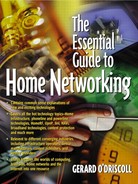ABOUT CONTENT PROTECTION
Original copyrighted content is delivered to your home network from a number of sources. It may be transmitted via satellite, terrestrial, or cable systems or recorded on various formats of digital media—CD-ROMs, DVDs, and hard drives. To protect this content from unauthorized copying, a number of different technologies are being developed. The development of these protection technologies is driven by the movie industry, which fears that the proliferation of digital technologies will encourage people to illegally copy content. For instance, it is relatively easy to download a new movie from your cable operator's broadband network and use your in-home network to make several copies of this film. The level of content protection that is used in a home networking environment will largely depend on the type of person that is running the system. Table 18.1 categorizes the different levels of danger that are associated with people who actively copy digital content.
| Groups of People | Threat to Content Revenue Streams |
|---|---|
| Casual copier | Low—The individual may record a film on their VCR for personal viewing. |
| Hobbyist | Relatively low—The individual may purchase or develop a device for storing Internet content. |
| Small-scale hacker | High—Operates a bank of recording devices (e.g., DVD players, VCRs, and CD-ROM drives). |
| Professional pirate | Very high—Well funded and very knowledgeable of the digital security systems. |
Much of the copy protection technology has been developed to "keep honest people honest." That is, it is aimed primarily at the first group identified in Table 18.1. All the technologies that have been proposed or developed so far have been breakable, and the breaches have become accessible to the casual copier as upgrades to consumer A/V products.
An important part of the strategy behind copy protection is legal prosecution. Legal means are used against the latter two categories. It is clearly impractical to initiate legal action against average consumers. The use of copy protection technology is partly to force the copier to buy pirate equipment to make illegal copies. The distribution of pirate technology is illegal. Again, this gives the industry a means to prosecute those in the latter two groups who would make a business of distributing this technology.
For honest people, an in-home copy protection system must provide a number of features:
It must not degrade the quality of the signal that is used by our in-home appliances.
We should not need to know about a complex protection system running on our network unless we decide to make pirate copies. In other words, any content protection system that runs in our home is transparent.
It does not add significantly to the cost of appliances.
All content protection systems must be designed to work with other computing and A/V devices.
Over the past year, a couple of factors have accelerated the need for a standard copyright protection system. Television producers are not overly excited about releasing digital content that can be easily pirated. Consequently, the drive for copy protection systems has largely been from the movie industry.
In addition, all DVD players with a IEEE 1394 interface port that are manufactured today are required by law to comply with an industry-wide digital-protection scheme. These factors have acted as a catalyst in developing new standards that address the copyright protection of video, audio, and data in a digital format. The remaining sections in this chapter will explain in detail the groups, proposals, specifications, and technologies that are associated with these new global protection standards.
